Teaching Clinical Reasoning to Veterinary Medical Learners with a Case Example
Abstract
1. Introduction
2. Background of Clinical Reasoning
2.1. Types of Clinical Reasoning
2.2. The Role of Context in Clinical Reasoning
2.3. The Role of the Social Environment in Clinical Reasoning
3. Teaching Clinical Reasoning
3.1. Consider Client ± Patient Situation
3.2. Collect Data
3.3. Analyze Data and Identify Problems ± Issues
3.3.1. Data Organization
3.3.2. Problem Representation
3.3.3. Generation of List of Tested Hypotheses
3.3.4. Refinement of Tested Hypotheses
3.4. Establish Mutually Agreed Goals
3.5. Take Action
3.6. Evaluate the Outcomes
3.7. Reflect on the Process and New Learning
4. Instructors’ Preparedness for Delivering Teaching in Clinical Reasoning
5. Conclusions
6. Glossary of Terms
Funding
Institutional Review Board Statement
Informed Consent Statement
Conflicts of Interest
References
- Neill, C.; Vinten, C.; Maddison, J. Use of inductive, Problem-Based clinical reasoning enhances diagnostic accuracy in final-year veterinary students. J. Vet. Med. Educ. 2020, 47, 506–515. [Google Scholar] [CrossRef] [PubMed]
- Audétat, M.C.; Laurin, S.; Sanche, G.; Béïque, C.; Fon, N.C.; Blais, J.G.; Charlin, B. Clinical reasoning difficulties: A taxonomy for clinical teachers. Med. Teach. 2013, 35, e984–e989. [Google Scholar] [CrossRef] [PubMed]
- Scott, I.A. Errors in clinical reasoning: Causes and remedial strategies. BMJ 2009, 338, b1860. [Google Scholar] [CrossRef]
- Audétat, M.-C.; Laurin, S.; Dory, V.; Charlin, B.; Nendaz, M.R. Diagnosis and management of clinical reasoning difficulties: Part II. Clinical reasoning difficulties: Management and remediation strategies. Med. Teach. 2017, 39, 797–801. [Google Scholar] [CrossRef]
- Amey, L.; Donald, K.J.; Teodorczuk, A. Teaching clinical reasoning to medical students. Br. J. Hosp. Med. 2017, 78, 399–401. [Google Scholar] [CrossRef]
- Lambe, K.A.; O’Reilly, G.; Kelly, B.D.; Curristan, S. Dual-process cognitive interventions to enhance diagnostic reasoning: A systematic review. BMJ Qual. Saf. 2016, 25, 808–820. [Google Scholar] [CrossRef] [PubMed]
- Daniel, M.; Carney, M.; Khandelwal, S.; Merritt, C.; Cole, M.; Malone, M.; Hemphill, R.R.; Peterson, W.; Burkhardt, J.; Hopson, L.; et al. Cognitive debiasing strategies: A faculty development workshop for clinical teachers in emergency medicine. MedEdPORTAL 2017, 13, 10646. [Google Scholar] [CrossRef]
- Graber, M.L. Educational strategies to reduce diagnostic error: Can you teach this stuff? Adv. Health Sci. Educ. Theory Pract. 2009, 14, 63–69. [Google Scholar] [CrossRef]
- Cutrer, W.B.; Sullivan, W.M.; Fleming, A.E. Educational strategies for improving clinical reasoning. Curr. Probl. Pediatr. Adolesc. Health Care 2013, 43, 248–257. [Google Scholar] [CrossRef]
- Cohen, A.; Sur, M.; Weisse, M.; Moffett, K.; Lancaster, J.; Saggio, R.; Singhal, G.; Thammasitboon, S. Teaching diagnostic reasoning to faculty using an assessment for learning tool: Training the trainer. MedEdPORTAL 2020, 16, 10938. [Google Scholar] [CrossRef]
- O’Sullivan, E.; Schofield, S. Cognitive bias in clinical medicine. J. R. Coll. Physicians Edinb. 2018, 48, 225–232. [Google Scholar] [CrossRef]
- Konopasky, A.; Artino, A.R.; Battista, A.; Ohmer, M.; Hemmer, P.A.; Torre, D.; Ramani, D.; Merrienboer, J.V.; Teunissen, P.W.; McBee, E.; et al. Understanding context specificity: The effect of contextual factors on clinical reasoning. Diagnosis 2020, 7, 257–264. [Google Scholar] [CrossRef]
- Bordage, G. Why did I miss the diagnosis? Some cognitive explanations and educational implications. Acad. Med. 1999, 74, S138–S143. [Google Scholar] [CrossRef]
- Graber, M.L.; Kissam, S.; Payne, V.L.; Meyer, A.N.D.; Sorensen, A.; Lenfestey, N.; Tant, E.; Henriksen, K.; LaBresh, K.; Singh, H. Cognitive interventions to reduce diagnostic error: A narrative review. BMJ Qual. Saf. 2012, 21, 535–557. [Google Scholar] [CrossRef]
- Oxtoby, C.; Ferguson, E.; White, K.; Mossop, L. We need to talk about error: Causes and types of error in veterinary practice. Vet. Rec. 2015, 177, 438. [Google Scholar] [CrossRef]
- Rogers, J.C.; Swee, D.E.; Ullian, J.A. Teaching medical decision making and students’ clinical problem solving skills. Med. Teach. 1991, 13, 157–164. [Google Scholar] [CrossRef] [PubMed]
- Koufidis, C.; Manninen, K.; Nieminen, J.; Wohlin, M.; Silén, C. Unravelling the polyphony in clinical reasoning research in medical education. J. Eval. Clin. Pract. 2021, 27, 438–450. [Google Scholar] [CrossRef] [PubMed]
- Ramaekers, S.P.J.; Van Beukelen, P.; Kremer, W.D.J.; Van Keulen, H.; Pilot, A. Instructional model for training competence in solving clinical problems. J. Vet. Med. Educ. 2011, 38, 360–372. [Google Scholar] [CrossRef]
- Humm, K.R.; May, S.A. Clinical reasoning by veterinary students in the first-opinion setting: Is it encouraged? Is it practiced? J. Vet. Med. Educ. 2018, 45, 156–162. [Google Scholar] [CrossRef] [PubMed]
- Young, M.E.; Thomas, A.; Lubarsky, S.; Gordon, D.; Gruppen, L.D.; Rencic, J.; Ballard, T.; Holmboe, E.; Da Silva, A.; Ratcliffe, T.; et al. Mapping clinical reasoning literature across the health professions: A scoping review. BMC Med. Educ. 2020, 20, 107. [Google Scholar] [CrossRef]
- Harasym, P.H.; Tsai, T.-C.; Hemmati, P. Current trends in developing medical students’ critical thinking abilities. Kaohsiung J. Med. Sci. 2008, 24, 341–355. [Google Scholar] [CrossRef]
- Young, M.; Thomas, A.; Gordon, D.; Gruppen, L.; Lubarsky, S.; Rencic, J.; Ballard, T.; Holmboe, E.; Da Silva, A.; Ratcliffe, T.; et al. The terminology of clinical reasoning in health professions education: Implications and considerations. Med. Teach. 2019, 41, 1277–1284. [Google Scholar] [CrossRef]
- Australian Veterinary Boards Council. AVBC Day One Competencies—Version 1 January 2024. Available online: https://avbc.asn.au/wp-content/uploads/2023/01/AVBC-Day-One-Competencies_Final_2024-v1-Jan-24.pdf (accessed on 21 October 2023).
- Royal College of Veterinary Surgeons. RCVS Day One Competences. Available online: https://www.rcvs.org.uk/news-and-views/publications/rcvs-day-one-competences-feb-2022/ (accessed on 21 October 2023).
- European Coordinating Committee on Veterinary Training. List of subjects and Day One Competences as approved by ECCVT on 17 January 2019. Available online: https://www.eaeve.org/fileadmin/downloads/eccvt/List_of_subjects_and_Day_One_Competences_approved_on_17_January_2019.pdf (accessed on 21 October 2023).
- Croskerry, P. A universal model of diagnostic reasoning. Acad. Med. 2009, 84, 1022–1028. [Google Scholar] [CrossRef]
- Ledley, R.S.; Lusted, L.B. Reasoning foundations of medical diagnosis; symbolic logic, probability, and value theory aid our understanding of how physicians reason. Science 1959, 130, 9–21. [Google Scholar] [CrossRef]
- Elstein, A.S.; Shulman, L.S.; Sprafka, S.A. Medical Problem Solving: An Analysis of Clinical Reasoning; Harvard University Press: Cambridge, MA, USA, 1978. [Google Scholar]
- Ruczynski, L.I.; van de Pol, M.H.; Schouwenberg, B.J.; Laan, R.F.; Fluit, C.R. Learning clinical reasoning in the workplace: A student perspective. BMC Med. Educ. 2022, 22, 19. [Google Scholar] [CrossRef]
- Gruppen, L.D. Clinical reasoning: Defining it, teaching it, assessing it, studying it. West. J. Emerg. Med. 2017, 18, 4–7. [Google Scholar] [CrossRef]
- Koufidis, C.; Manninen, K.; Nieminen, J.; Wohlin, M.; Silén, C. Grounding judgement in context: A conceptual learning model of clinical reasoning. Med. Educ. 2020, 54, 1019–1028. [Google Scholar] [CrossRef]
- Abrandt Dahlgren, M.; Valeskog, K.; Johansson, K.; Edelbring, S. Understanding clinical reasoning: A phenomenographic study with entry-level physiotherapy students. Physiother. Theory Pract. 2022, 38, 2817–2826. [Google Scholar] [CrossRef]
- Weinstein, A.; Gupta, S.; Pinto-Powell, R.; Jackson, J.; Appel, J.; Roussel, D.; Daniel, M. Diagnosing and remediating clinical reasoning difficulties: A faculty development workshop. MedEdPORTAL 2017, 13, 10650. [Google Scholar] [CrossRef]
- Dhaliwal, G. Developing teachers of clinical reasoning. Clin. Teach. 2013, 10, 313–317. [Google Scholar] [CrossRef]
- Audétat, M.-C.; Lubarsky, S.; Blais, J.-G.; Charlin, B. Clinical reasoning: Where do we stand on identifying and remediating difficulties? Creat. Educ. 2013, 4, 42–48. [Google Scholar] [CrossRef]
- Pinnock, R.; Welch, P. Learning clinical reasoning. J. Paediatr. Child Health 2014, 50, 253–257. [Google Scholar] [CrossRef]
- Mohd Tambeh, S.N.; Yaman, M.N. Clinical reasoning training sessions for health educators—A scoping review. J. Taibah Univ. Med. Sci. 2023, 18, 1480–1492. [Google Scholar] [CrossRef] [PubMed]
- Gonzalez, L.; Nielsen, A.; Lasater, K. Developing students’ clinical reasoning skills: A faculty guide. J. Nurs. Educ. 2021, 60, 485–493. [Google Scholar] [CrossRef] [PubMed]
- Linn, A.; Khaw, C.; Kildea, H.; Tonkin, A. Clinical reasoning: A guide to improving teaching and practice. Aust. Fam. Physician 2012, 41, 18–20. [Google Scholar]
- Vinten, C.E.K.; Cobb, K.A.; Freeman, S.L.; Mossop, L.H. An investigation into the clinical reasoning development of veterinary students. J. Vet. Med. Educ. 2016, 43, 398–405. [Google Scholar] [CrossRef]
- Weinstein, A.; Pinto-Powell, R. Introductory clinical reasoning curriculum. MedEdPORTAL 2016, 12, 10370. [Google Scholar] [CrossRef]
- Pelaccia, T.; Tardif, J.; Triby, E.; Charlin, B. An analysis of clinical reasoning through a recent and comprehensive approach: The dual-process theory. Med. Educ. Online 2011, 16, 5890. [Google Scholar] [CrossRef]
- Levett-Jones, T.; Hoffman, K.; Dempsey, J.; Jeong, S.Y.-S.; Noble, D.; Norton, C.A.; Roche, J.; Hickey, N. The ‘five rights’ of clinical reasoning: An educational model to enhance nursing students’ ability to identify and manage clinically ‘at risk’ patients. Nurse Educ. Today 2010, 30, 515–520. [Google Scholar] [CrossRef]
- Evans, J.S.B.T. Intuition and reasoning: A Dual-Process perspective. Psychol. Inq. 2010, 21, 313–326. [Google Scholar] [CrossRef]
- Kassirer, J.P. Teaching clinical reasoning: Case-based and coached. Acad. Med. 2010, 85, 1118–1124. [Google Scholar] [CrossRef]
- Vinten, C.E.K. Clinical reasoning in veterinary practice. Vet. Evid. 2020, 5, 2–8. [Google Scholar] [CrossRef]
- Vandeweerd, J.-M. Understanding clinical decision making in small animal practice. Vet. Rec. 2019, 185, 167–169. [Google Scholar] [CrossRef]
- May, S.A. Clinical reasoning and Case-Based Decision Making: The fundamental challenge to veterinary educators. J. Vet. Med. Educ. 2013, 40, 200–209. [Google Scholar] [CrossRef]
- Cockcroft, P.D. Diagnosis and clinical reasoning in cattle practice. In Bovine Medicine, 3rd ed.; Cockcroft, P.D., Ed.; John Wiley & Sons, Ltd.: Chichester, UK, 2015; pp. 124–132. [Google Scholar]
- Tomlin, J.L.; Pead, M.J.; May, S.A. Attitudes of veterinary faculty to the assessment of clinical reasoning using extended matching questions. J. Vet. Med. Educ. 2008, 35, 622–630. [Google Scholar] [CrossRef]
- Wainwright, S.F.; Shepard, K.F.; Harman, L.B.; Stephens, J. Novice and experienced physical therapist clinicians: A comparison of how reflection is used to inform the clinical decision-making process. Phys. Ther. 2010, 90, 75–88. [Google Scholar] [CrossRef]
- Richards, J.B.; Hayes, M.M.; Schwartzstein, R.M. Teaching clinical reasoning and critical thinking: From cognitive theory to practical application. Chest 2020, 158, 1617–1628. [Google Scholar] [CrossRef]
- Norman, G.R.; Monteiro, S.D.; Sherbino, J.; Ilgen, J.S.; Schmidt, H.G.; Mamede, S. The causes of errors in clinical reasoning: Cognitive biases, knowledge deficits, and dual process thinking. Acad. Med. 2017, 92, 23–30. [Google Scholar] [CrossRef]
- Carr, A.N.; Kirkwood, R.N.; Petrovski, K.R. Practical use of the (Observer)—Reporter—Interpreter—Manager—Expert ((O)RIME) framework in veterinary clinical teaching with a clinical example. Encyclopedia 2022, 2, 1666–1677. [Google Scholar] [CrossRef]
- Round, A. Introduction to clinical reasoning. J. Eval. Clin. Pract. 2001, 7, 109–117. [Google Scholar] [CrossRef]
- Cockcroft, P.D. Clinical reasoning and decision analysis. Vet. Clin. N. Am. Small Anim. Pract. 2007, 37, 499–520. [Google Scholar] [CrossRef]
- Custers, E.J.F.M. Thirty years of illness scripts: Theoretical origins and practical applications. Med. Teach. 2015, 37, 457–462. [Google Scholar] [CrossRef]
- Croskerry, P.; Singhal, G.; Mamede, S. Cognitive debiasing 2: Impediments to and strategies for change. BMJ Qual. Saf. 2013, 22 (Suppl. S2), ii65–ii72. [Google Scholar] [CrossRef]
- Croskerry, P.; Singhal, G.; Mamede, S. Cognitive debiasing 1: Origins of bias and theory of debiasing. BMJ Qual. Saf. 2013, 22 (Suppl. S2), ii58–ii64. [Google Scholar] [CrossRef]
- Carr, A.N.M.; Kirkwood, R.N.; Petrovski, K.R. Effective veterinary clinical teaching in a variety of teaching settings. Vet. Sci. 2022, 9, 17. [Google Scholar] [CrossRef]
- McBee, E.; Ratcliffe, T.; Lambert, S.; Daniel, O.N.; Meyer, H.; Madden, S.J.; Durning, S.J. Context and clinical reasoning. Perspect. Med. Educ. 2018, 7, 256–263. [Google Scholar] [CrossRef]
- Durning, S.J.; Artino, A.R.; Boulet, J.R.; Dorrance, K.; van der Vleuten, C.; Schuwirth, L. The impact of selected contextual factors on experts’ clinical reasoning performance (does context impact clinical reasoning performance in experts?). Adv. Health Sci. Educ. Theory Pract. 2012, 17, 65–79. [Google Scholar] [CrossRef]
- McBee, E.; Ratcliffe, T.; Picho, K.; Artino, A.R.; Schuwirth, L.; Kelly, W.; Masel, J.; van der Vleuten, C.; Durning, S.J. Consequences of contextual factors on clinical reasoning in resident physicians. Adv. Health Sci. Educ. Theory Pract. 2015, 20, 1225–1236. [Google Scholar] [CrossRef]
- McCarthy, M.C. Detecting acute confusion in older adults: Comparing clinical reasoning of nurses working in acute, long-term, and community health care environments. Res. Nurs. Health 2003, 26, 203–212. [Google Scholar] [CrossRef]
- Schmidt, H.G.; Mamede, S. How to improve the teaching of clinical reasoning: A narrative review and a proposal. Med. Educ. 2015, 49, 961–973. [Google Scholar] [CrossRef]
- Petrovski, K.; McArthur, M. The art and science of consultations in bovine medicine: Use of modified Calgary—Cambridge guides. Maced. Vet. Rev. 2015, 38, 137–147. [Google Scholar] [CrossRef]
- Croskerry, P. From mindless to mindful practice—Cognitive bias and clinical decision daking. N. Engl. J. Med. 2013, 368, 2445–2448. [Google Scholar] [CrossRef]
- Carr, A.N.; Kirkwood, R.N.; Petrovski, K.R. The art and science of consultations in bovine medicine: Use of Modified Calgary—Cambridge Guides, Part 2. Maced. Vet. Rev. 2023, 46, 5–16. [Google Scholar] [CrossRef]
- Casapulla, S.; Longenecker, R.; Beverly, E.A. The value of clinical jazz: Teaching critical reflection on, in, and toward action. Fam. Med. 2016, 48, 377–380. [Google Scholar]
- Larsen, D.P.; London, D.A.; Emke, A.R. Using reflection to influence practice: Student perceptions of daily reflection in clinical education. Perspect. Med. Educ. 2016, 5, 285–291. [Google Scholar] [CrossRef]
- Schurmans, L.; De Coninck, D.; Schoenmakers, B.; de Winter, P.; Toelen, J. Both medical and context elements influence the decision-making processes of pediatricians. Children 2022, 9, 403. [Google Scholar] [CrossRef]
- Gonzalez, L. Teaching clinical reasoning piece by piece: A clinical reasoning Concept-Based Learning method. J. Nurs. Educ. 2018, 57, 727–735. [Google Scholar] [CrossRef]
- Carr, A.N.; Kirkwood, R.N.; Petrovski, K.R. Using the five-microskills method in veterinary medicine clinical teaching. Vet. Sci. 2021, 8, 89. [Google Scholar] [CrossRef]
- Cooper, N.; Bartlett, M.; Gay, S.; Hammond, A.; Lillicrap, M.; Matthan, J.; Singh, M. Consensus statement on the content of clinical reasoning curricula in undergraduate medical education. Med. Teach. 2021, 43, 152–159. [Google Scholar] [CrossRef] [PubMed]
- Nielsen, A.; Stragnell, S.; Jester, P. Guide for reflection using the clinical judgment model. J. Nurs. Educ. 2007, 46, 513–516. [Google Scholar] [CrossRef]
- Jessee, M.A. Pursuing improvement in clinical reasoning: The integrated clinical education theory. J. Nurs. Educ. 2018, 57, 7–13. [Google Scholar] [CrossRef] [PubMed]
- Farnsworth, C.C.; Herman, J.D.; Osterstock, J.B.; Porterpan, B.L.; Willard, M.D.; Hooper, R.N.; Roussel, A.J., Jr.; Schmitz, D.G.; Fogelberg, K.; Kochevar, D.T. Assessment of clinical reasoning skills in veterinary students prior to and after the clinical year of training. J. Am. Vet. Med. Assoc. 2008, 233, 879–882. [Google Scholar] [CrossRef] [PubMed]
- Mallory, R.; Maciuba, J.M.; Roy, M.; Durning, S.J. Teaching clinical reasoning in the preclinical period. Mil. Med. 2023, 10, usad370. [Google Scholar] [CrossRef] [PubMed]
- Mauldin Pereira, M.; Artemiou, E.; Conan, A.; Köster, L.; Cruz-Martinez, L. Case-based studies and clinical reasoning development: Teaching opportunities and pitfalls for first year veterinary students. Med. Sci. Educ. 2018, 28, 175–179. [Google Scholar] [CrossRef]
- Chang, R.W.; Bordage, G.; Connell, K.J. The importance of early problem representation during case presentations. Acad. Med. 1998, 73, S109–S111. [Google Scholar] [CrossRef] [PubMed]
- Teixeira Ferraz Grünewald, S.; Grünewald, T.; Ezequiel, O.S.; Lucchetti, A.L.G.; Lucchetti, G. One-minute preceptor and SNAPPS for clinical reasoning: A systematic review and meta-analysis. Intern. Med. J. 2023, 53, 680–689. [Google Scholar] [CrossRef] [PubMed]
- Audétat, M.C.; Laurin, S.; Dory, V.; Charlin, B.; Nendaz, M.R. Diagnosis and management of clinical reasoning difficulties: Part I. Clinical reasoning supervision and educational diagnosis. Med. Teach. 2017, 39, 792–796. [Google Scholar] [CrossRef] [PubMed]
- Adams, N.E. Bloom’s taxonomy of cognitive learning objectives. J. Med. Libr. Assoc. 2015, 103, 152–153. [Google Scholar] [CrossRef]
- Fleming, A.; Cutrer, W.; Reimschisel, T.; Gigante, J. You too can teach clinical reasoning. Pediatrics 2012, 130, 795–797. [Google Scholar] [CrossRef]
- Munby, H. Reflection-in-action and reflection-on-action. Curr. Issues Educ. 1989, 9, 31–42. [Google Scholar] [CrossRef]
- Sandars, J. The use of reflection in medical education: AMEE Guide No. 44. Med. Teach. 2009, 31, 685–695. [Google Scholar] [CrossRef] [PubMed]
- Hunter, S.; Arthur, C. Clinical reasoning of nursing students on clinical placement: Clinical educators’ perceptions. Nurse Educ. Pract. 2016, 18, 73–79. [Google Scholar] [CrossRef]
- Croskerry, P. Cognitive forcing strategies in clinical decisionmaking. Ann. Emerg. Med. 2003, 41, 110–120. [Google Scholar] [CrossRef]
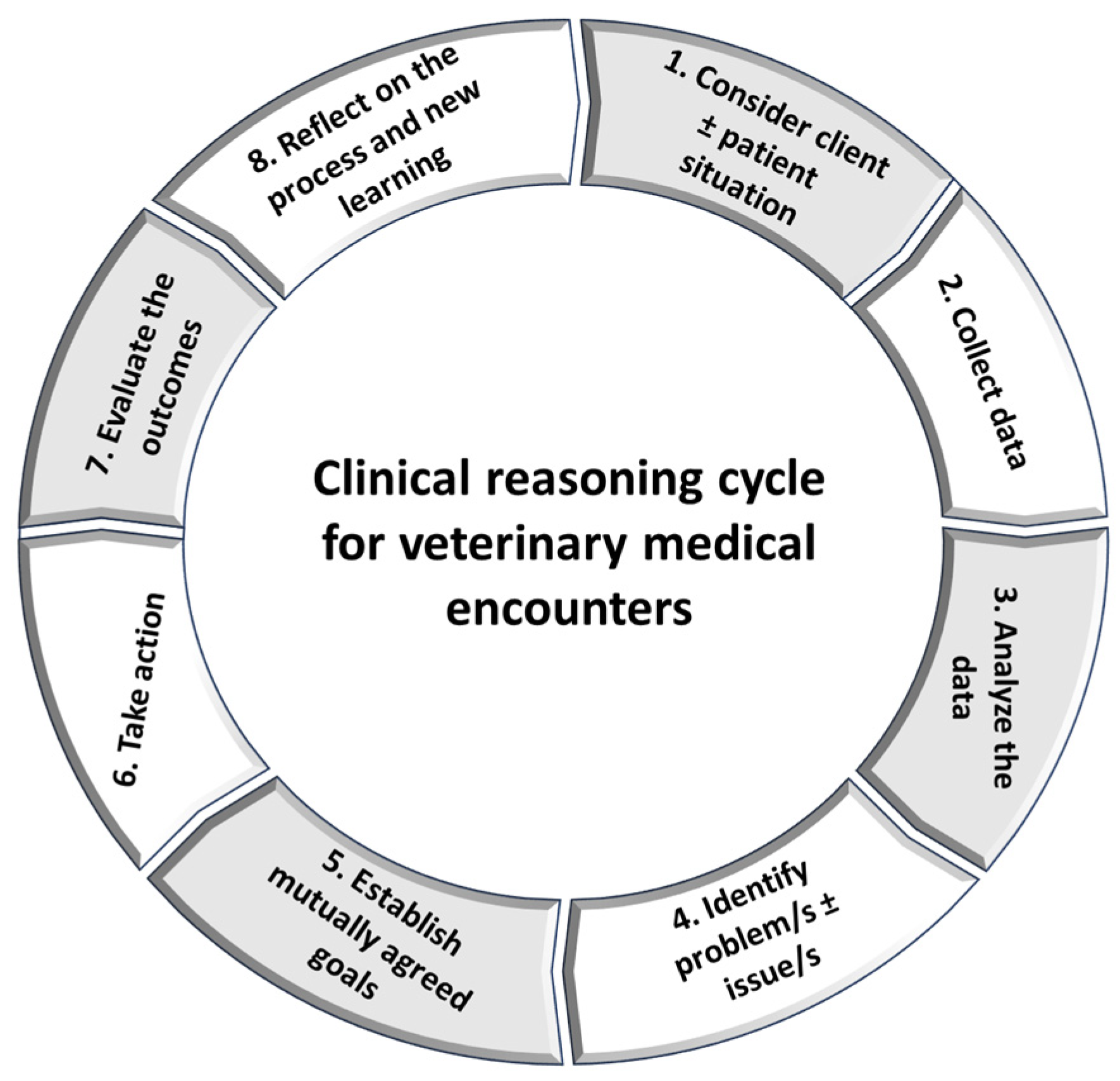
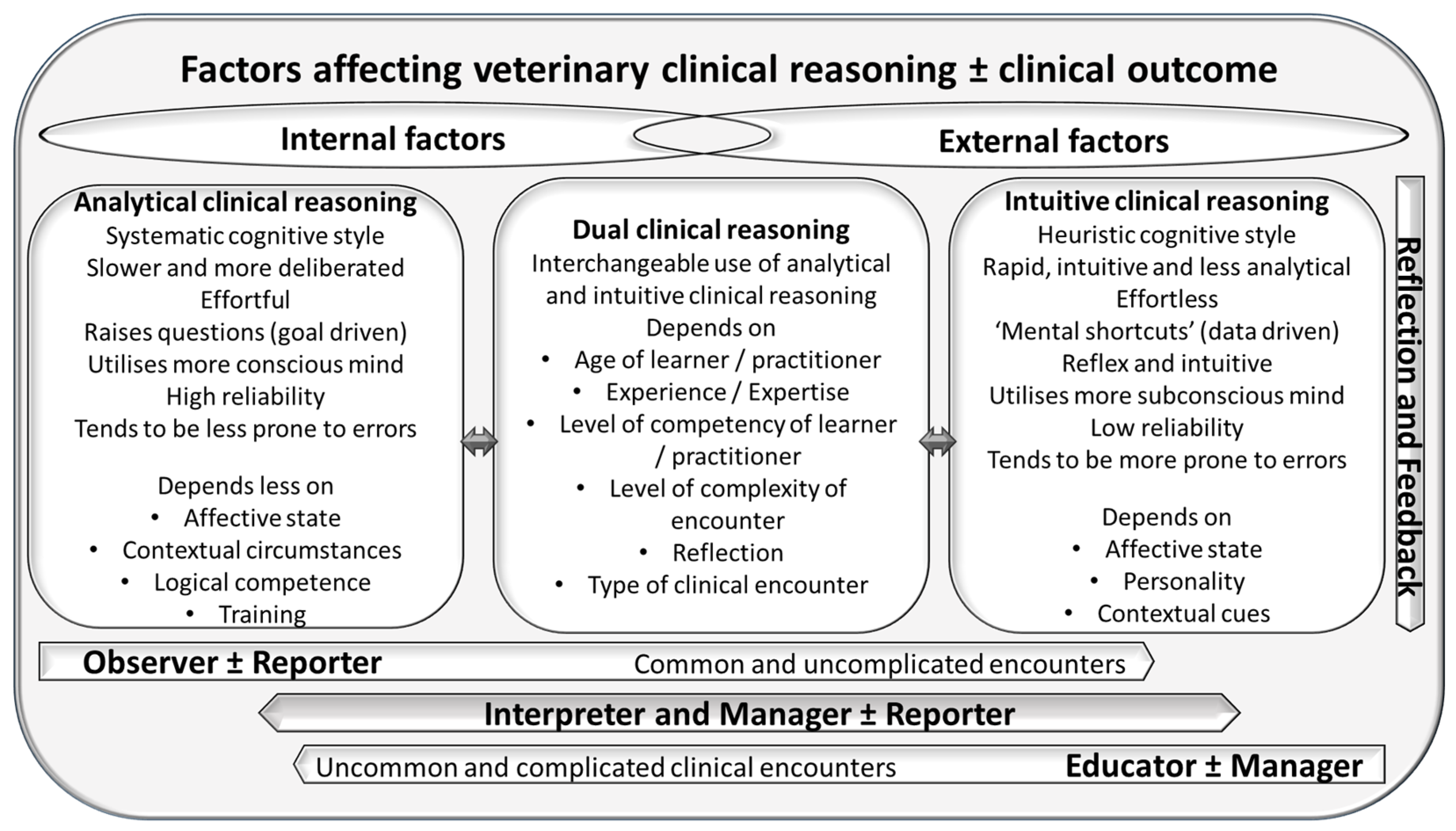
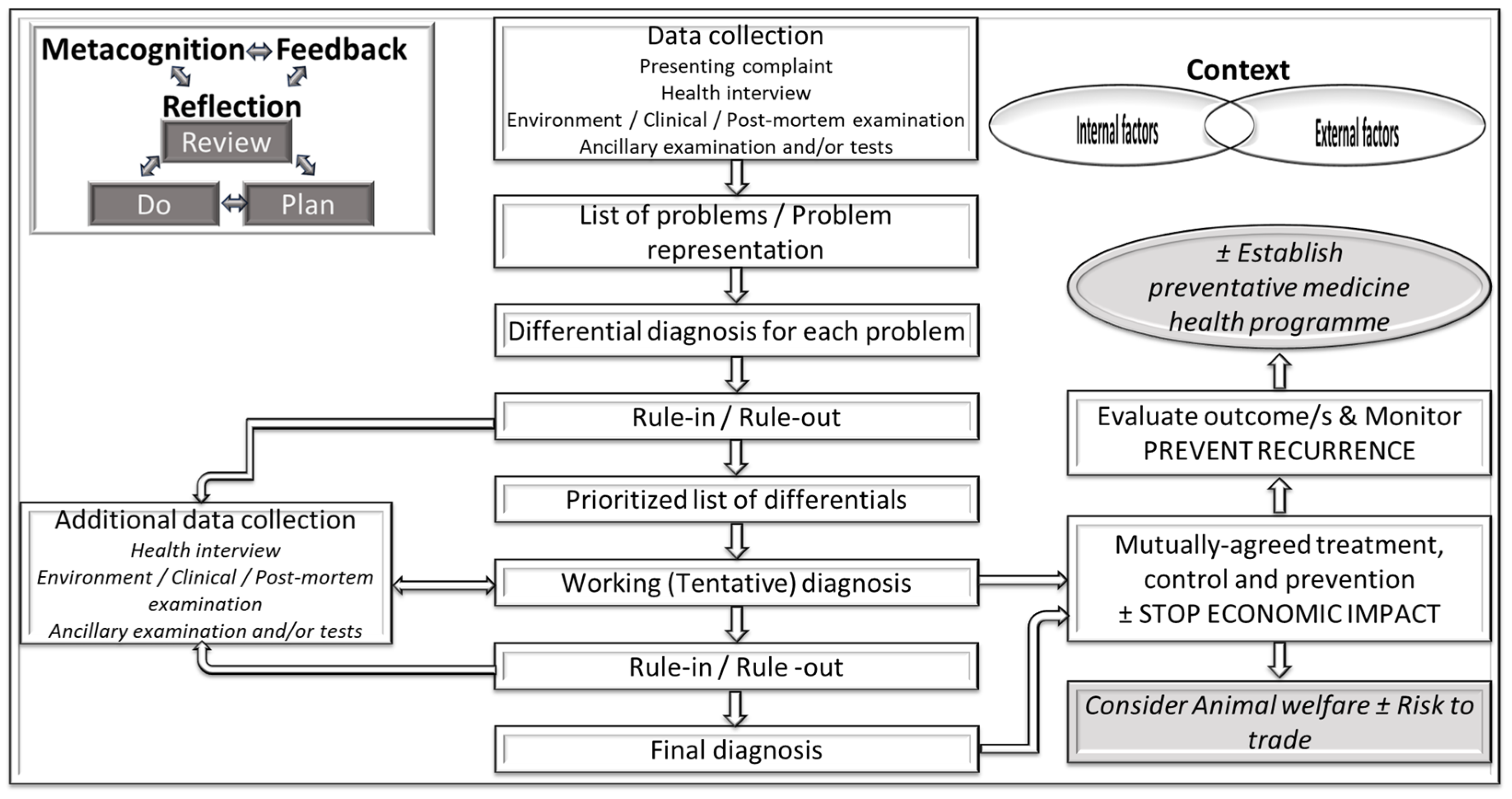
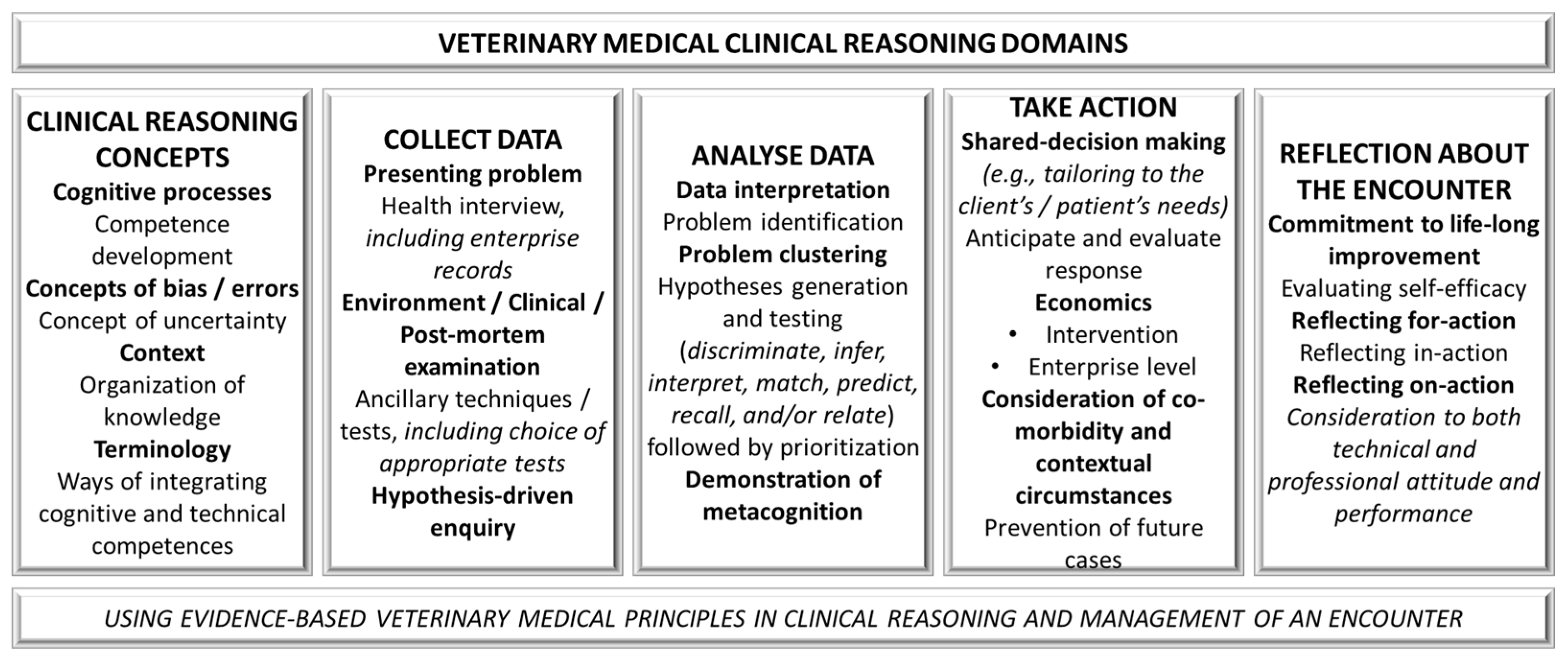
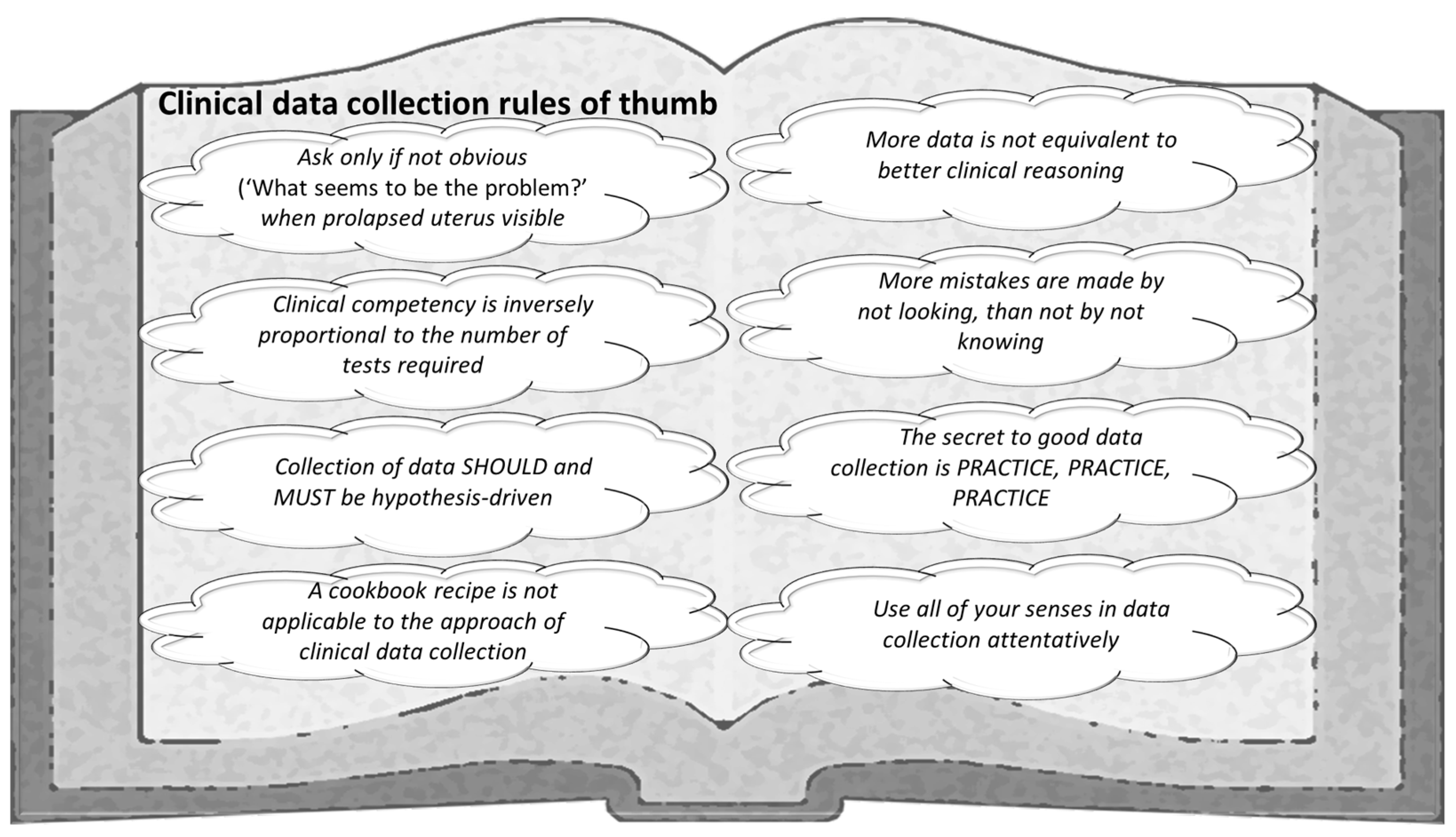
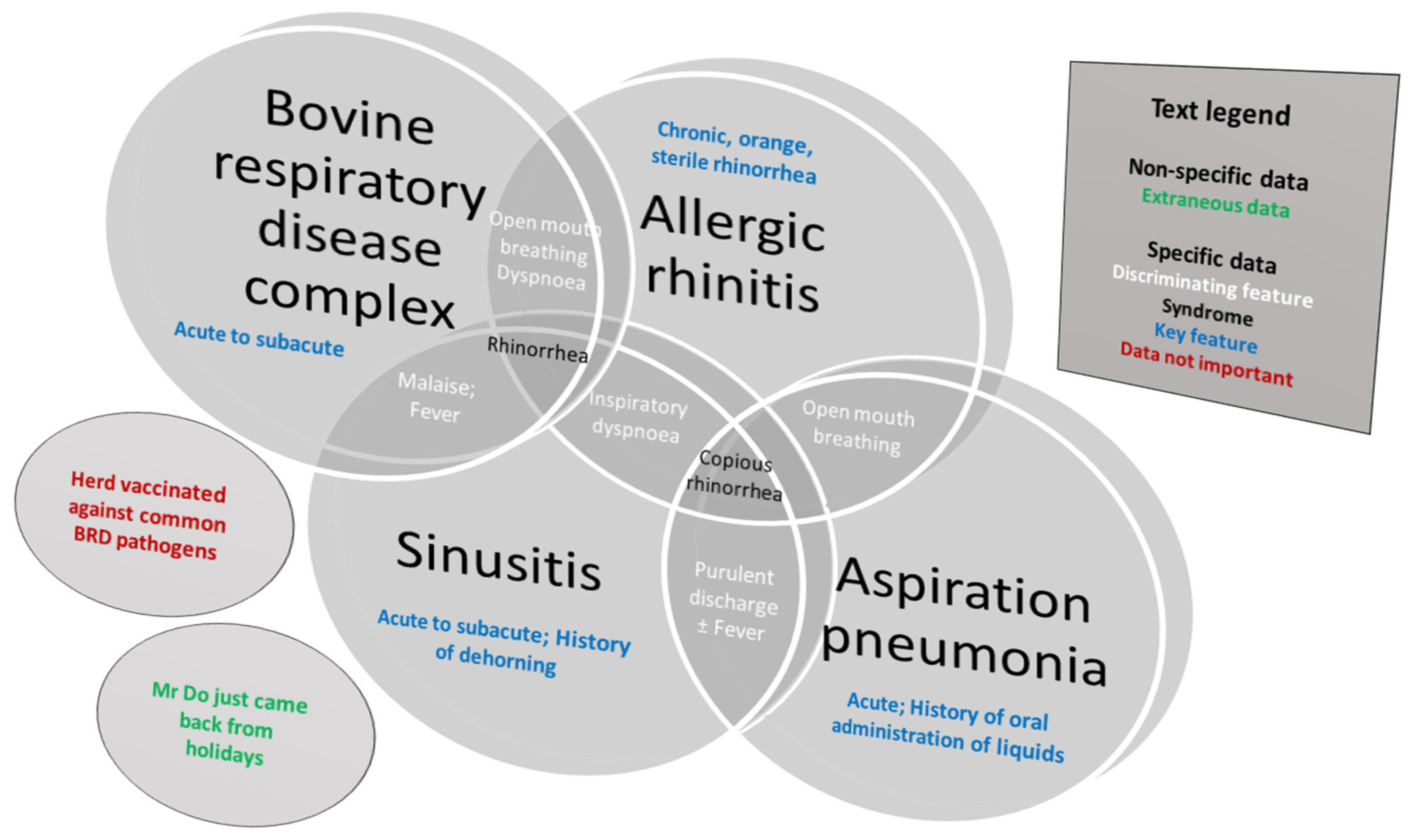
| Instructors | Learners |
|---|---|
| Ambiguity and complexity of the process [22,30,33,34,35] Being at level of educator in (O)RIME and using a lot of intuitive types of clinical reasoning [36] Curriculum design lacking stimulation of storage of knowledge in clinically relevant manner [30,36,37,38] Difficulty in explanation of cognitive processing of information to learner/s [34,36,37] Lack of awareness of clinical reasoning concepts [35] Lack of consideration of the clinical reasoning process when dealing with clinical encounters [39] Lack of training in teaching clinical reasoning [30,34,35,37] Relative lack of literature in journals frequently read by instructors involved with clinical teaching that are not directly employed in academia [34,36] | Ambiguity and complexity of the process [22,30,33,35] Being at levels lower than educator and using a lot the analytical type of clinical reasoning [36] Being unfamiliar with the work-based learning context Belief that clinical reasoning is ‘an art’ [36] Content-loaded curriculum [38] Curriculum design lacking stimulation of storage of knowledge in clinically relevant manner [30,36,37,38] Lack of ‘real-life’ situations training during theoretical portion of the curriculum [40] Lack of awareness of clinical reasoning concepts [35] Lack of confidence [38] Lack of explanation of cognitive processing of information by instructor/s [37,39,41] Lack of opportunities to practice clinical reasoning in safe environment [37,38] Lack of qualified instructors in teaching clinical reasoning [37,38] Lack of specific teaching of clinical reasoning processes [30,38,40] Late introduction of clinical reasoning into the curriculum [40] |
| Stage | Activity/Element | Example of Veterinary Medical Learner’s Synthesis of Information |
|---|---|---|
| Consider client ± patient situation | NA | Mr John Do is an experienced dairy farmer and has presented Daisy, a 4-year-old Jersey cow, that has been snorting and making noise on taking air though the nose for over 3 weeks, with both nostrils being affected. Daisy is otherwise ‘healthy’. Mr. Do just came back from holidays and she is still the same. |
| Collect data | Presenting problem | Snorting for over 3 weeks |
| Health interview | Immunized against common bovine respiratory disease (BRD) pathogens. Member of 450 cow herd (no other sick cows). | |
| Various examination steps | Hot summer. Environment and husbandry—no abnormalities detected (NAD). Bright and alert. Temperature, pulse, and respiration (TRP) + rumination—NAD. Inspiratory stridor. Increased respiratory effort. Air flow into nostrils decreased. Nasal flaring. Copious orange nasal discharge. No signs of pain. Capillary refill time (CRT) < 2 s. | |
| Ancillary examination techniques/tests | Swab taken from the nasal discharge, negative on culture. | |
| Analyze the data | Review data/problem representation | Mr. John Do is an experienced dairy farmer and has presented Daisy, a 4-year-old valuable Jersey cow, with chronic inspiratory dyspnea associated with bilateral, sterile, copious, mucoid, and non-purulent rhinorrhea. No other abnormalities detected in her, the other herd members, or the environment and management. |
| Review context | Client concerned about Daisy’s animal welfare. Valuable cow for the client. | |
| Problem identification | Copious nasal discharge that results in a partial blockage of the nasal cavity/upper airway. | |
| Recall knowledge | Exemplars/illness scripts/prototypes/semantic qualifiers Inspiratory dyspnea is common with partial or complete blockage of the upper airway. | |
| Interpretation | Upper airway blockage resulting in inspiratory dyspnea. | |
| Discrimination | Daisy is not febrile and does not appear to have generalized malaise. However, her respiratory effort is increased. | |
| Relating | Although Daisy has inspiratory dyspnea, her overall oxygenation does not seem to be affected. CRT < 2 s | |
| Inferring | Daisy’s oxygenation is probably OK whilst at rest, as she takes air through the mouth. It is likely to be compromised with increased level of activity. | |
| Matching | Non-purulent, copious rhinorrhea in cattle is often of allergic nature. | |
| Predicting | Even without treatment, Daisy seems not to be affected, and allergic conditions are likely to self-cure when the allergens disappear. | |
| Establish mutually agreed goals | NA | Daisy’s wellbeing is marginally affected. The most likely diagnosis is allergic rhinitis, which is not easily treated. We agree that the best course of action is to continue monitoring Daisy at every milking and with any sign of discomfort, you will contact us. If Daisy’s discomfort increases, we may consider prolonged administration of corticosteroids. Are we all on the same page? |
| Take action | NA | In this encounter, the best course of action is regular monitoring by the client. |
| Evaluate | NA | Daisy significantly improved a month later. As her condition is likely to recur in future years, the client may consider culling at the end of the milking season. Additionally, the disorder is characterized by suspected familial predisposition. |
| Reflection and new learning | NA | It would be good to be more confident in the diagnosis of allergic rhinitis by checking for eosinophilia and/or cytologic examination of the nasal discharge for eosinophils. Regular monitoring without a treatment intervention may be suitable in encounters where animal welfare or the image of the industry are not affected. Heredity of disorders in production animals may be important for the client. |
| External | Internal |
|---|---|
| Client ± patient-related Challenging learners/practitioner’s credentials [12,62,63] Client’s ± patient’s characteristics [12,13,26,32,42,62,64,65] Client’s wish/es and perceptions [32,62,66] Incorrect hypothesis suggestions [12,61,63,66] Language and vocabulary [12] Understanding of the problem [61,62] | Age, due to general problem-solving competence Awareness of biases and/or errors in clinical reasoning [10,65,67] Cognitive indolence [26,62] Cognitive overload [12,56,67] Communication skills [61,62,63,66,68,69] Experience [12,26,37,45,48,50,61,62,65] Expertise/level of development [12,14,57] Language and vocabulary [62] Level of knowledge in the field [42,61] Multitasking [12,26,42,52] Organization of mental representation [9] Personal affective state (e.g., emotional state) [3,13,26,30,42,48,52,53,61,62,63,67] Personal attitude (e.g., beliefs, confidence, contemplation, creativity, curiosity, flexibility, inquisitiveness, intellectual integrity, intuition, motivation, open-mindedness, perseverance, prejudices, and values) [3,32,42,44,52,62,64] Personal psychomotor state (e.g., fatigues, sleep deprivation, and stress) [3,12,13,26,42,48,52,56,61,62,67] Philosophical preconceptions [42,62,64] Philosophical perspective [13,64] Reflection [9,51,70] |
| Encounter-related Available resources [3,12,13,26,66] Available versus required time for the encounter [3,12,13,42,52] Clinical encounter (e.g., urgency) [26,62] Clinical settings [26,30,64,66] Cultural environment [66] Distractors (e.g., noise) [26,42,52] Frequency of encounter Environment [52,62] Level of complexity Team dynamics [52] | |
| System-related Client–learner/practitioner relationship [32,61,62,63] Ethical issues [26,66] Financial constraints [3,66] Industry-related factors and issues [66] Legal factors and issues [66] Social environment [3,12,13,17,29,31,38,47,48,51,55,71] Support from the team [13] |
| Competence/Skill | Examples |
|---|---|
| Acquiring | Cognitive and metacognitive competences; general problem-solving skills |
| Acting | Hypothesis-driven; purposefulness; tailoring |
| Adjusting/consideration to context | Tailoring |
| Analysis of information | Analyzing; applying; comparing; conceptualizing; contrasting; evaluating |
| Commitment to improvement | Self-directed learning; self-reflection |
| Communication | Non-verbal and verbal |
| Inquisitiveness and observation | Communicating; focused observation; information seeking; noticing |
| Integration/synthesis of information | Abstracting; aggregating; assimilating; activating neural networks |
| Interpretation of context/information | Interpreting; recognizing deviations from expected patterns; responding to analysis of information |
| Open-mindedness | Flexibility |
| Prioritization of context/information | Making sense; prioritizing information |
| Professional demeanor | |
| Recognition of self-limitations of knowledge/resources/skills | Reflecting; self-awareness |
| Reflective practice | Self-analysis/-evaluation/-monitoring; self-awareness/-esteem/-regulation; self-efficacy |
| Summarizing information | Abstracting; use of medical terminology |
| Step 1 | Step 2 | Step 3 | ||
|---|---|---|---|---|
| List of Context/Clinical Data Collected | Data Categorization | Data Clustering | ||
| Information | Category | Information | Indicative of | |
| Experienced dairy farmer | Experienced dairy farmer | Extraneous | Daisy, 4-year-old, Jersey cow | Signalment |
| Daisy, 4-year-old, Jersey cow | Daisy, 4-year-old, Jersey cow | Signalment | Daisy is valuable | |
| Snorting | Snorting | Specific | ||
| Making noise on taking air through the nose | Making noise on taking air through the nose | Specific | Snorting | Involvement in the upper respiratory tract |
| Over 3 weeks | Over 3 weeks | Specific | Making noise on taking air through the nose | |
| Both nostrils affected air flow into nostrils decreased, nasal flaring. | Both nostrils affected, air flow into nostrils decreased, nasal flaring. | Specific | Inspiratory stridor | |
| Mr. Do just came back from holidays | Mr. Do just came back from holidays | Extraneous | Both nostrils affected air flow into nostrils decreased, nasal flaring. | |
| Immunized against common BRD pathogens | Immunized against common BRD pathogens | Non-specific | Copious orange nasal discharge | |
| Member of 450 cows’ herd | Member of 450 cows’ herd | Non-specific | Nasal discharge negative on culture | |
| No other sick cows | No other sick cows | Specific | ||
| Hot summer | Hot summer | Extraneous | Over 3 weeks | Chronology |
| NAD environment | NAD environment | Extraneous | ||
| NAD husbandry | NAD husbandry | Extraneous | Daisy bright and alert | No generalized malaise; no fever |
| Daisy bright and alert | Daisy bright and alert | Non-specific | TPR + rumination NAD | |
| TPR + rumination NAD | TPR + rumination NAD | Non-specific | No signs of pain | |
| Inspiratory stridor | Inspiratory stridor | Specific | Immunized against common BRD pathogens | |
| Copious orange nasal discharge | Copious orange nasal discharge | Specific | ||
| No signs of pain | No signs of pain | Non-specific | Member of 450 cows’ herd | Unlikely to be contagious |
| Nasal discharge negative on culture | Nasal discharge negative on culture | Specific | No other sick cows | |
| Mr. Do concerned for Daisy’s animal welfare | Mr. Do concerned for Daisy’s animal welfare | Extraneous | ||
| Daisy is valuable | Daisy is valuable | Signalment | ||
Disclaimer/Publisher’s Note: The statements, opinions and data contained in all publications are solely those of the individual author(s) and contributor(s) and not of MDPI and/or the editor(s). MDPI and/or the editor(s) disclaim responsibility for any injury to people or property resulting from any ideas, methods, instructions or products referred to in the content. |
© 2024 by the authors. Licensee MDPI, Basel, Switzerland. This article is an open access article distributed under the terms and conditions of the Creative Commons Attribution (CC BY) license (https://creativecommons.org/licenses/by/4.0/).
Share and Cite
Carr, A.N.; Ferlini Agne, G.; Kirkwood, R.N.; Petrovski, K.R. Teaching Clinical Reasoning to Veterinary Medical Learners with a Case Example. Encyclopedia 2024, 4, 753-775. https://doi.org/10.3390/encyclopedia4020048
Carr AN, Ferlini Agne G, Kirkwood RN, Petrovski KR. Teaching Clinical Reasoning to Veterinary Medical Learners with a Case Example. Encyclopedia. 2024; 4(2):753-775. https://doi.org/10.3390/encyclopedia4020048
Chicago/Turabian StyleCarr, Amanda (Mandi) Nichole, Gustavo Ferlini Agne, Roy Neville Kirkwood, and Kiro Risto Petrovski. 2024. "Teaching Clinical Reasoning to Veterinary Medical Learners with a Case Example" Encyclopedia 4, no. 2: 753-775. https://doi.org/10.3390/encyclopedia4020048
APA StyleCarr, A. N., Ferlini Agne, G., Kirkwood, R. N., & Petrovski, K. R. (2024). Teaching Clinical Reasoning to Veterinary Medical Learners with a Case Example. Encyclopedia, 4(2), 753-775. https://doi.org/10.3390/encyclopedia4020048








